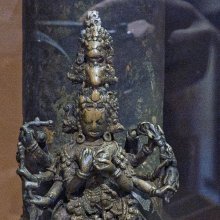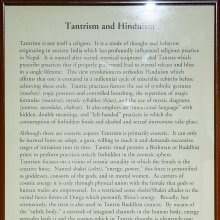Breathing: 1 definition
Introduction:
Breathing means something in Hinduism, Sanskrit. If you want to know the exact meaning, history, etymology or English translation of this term then check out the descriptions on this page. Add your comment or reference to a book if you want to contribute to this summary article.
Images (photo gallery)
In Hinduism
Natyashastra (theatrics and dramaturgy)
Source: Shodhganga: Elements of Art and Architecture in the Trtiyakhanda of the Visnudharmottarapurana (natya)(Normal) Breathing (expression) is associated with Udvāhita: one of the “seven movements of the chest” (in Sanskrit Dramas), as conveyed through Āṅgikābhinaya: one of the four divisions of Abhinaya or “ways to convey or represent one’s emotion to others”, according to the Nāṭyaśāstra and the Viṣṇudharmottarapurāṇa, an ancient Sanskrit text which (being encyclopedic in nature) deals with a variety of cultural topics such as arts, architecture, music, grammar and astronomy.—The āṅgikābhinaya includes the histrionic representation of the limbs which is simply known as physical gestures. There are five kinds of chest movements accepted by the Viṣṇudharmottarapurāṇa as well as the Nāṭyaśāstra. In the udvāhita movement, the chest position is kept slightly upward to show normal breathing and also yawning.

Natyashastra (नाट्यशास्त्र, nāṭyaśāstra) refers to both the ancient Indian tradition (shastra) of performing arts, (natya—theatrics, drama, dance, music), as well as the name of a Sanskrit work dealing with these subjects. It also teaches the rules for composing Dramatic plays (nataka), construction and performance of Theater, and Poetic works (kavya).
See also (Relevant definitions)
Starts with: Breathing exercise.
Ends with: Fast breathing.
Full-text (+585): Shvasa, Shvasana, Pranayama, Nihshvasana, Nihshvasa, Ashvasa, Ucchvasa, Pranana, Anapanasati, Nishvasa, Pranatha, Nishshvasana, Anapana, Pranamaya, Jhulakanem, Prashvasa, Dashanocchishtha, Vinishvasa, Ashvasat, Svarashastra.
Relevant text
Search found 255 books and stories containing Breathing; (plurals include: Breathings). You can also click to the full overview containing English textual excerpts. Below are direct links for the most relevant articles:
Satapatha-brahmana (by Julius Eggeling)
Kāṇḍa XII, adhyāya 3, brāhmaṇa 2 < [Twelfth Kāṇḍa]
Kāṇḍa I, adhyāya 4, brāhmaṇa 3 < [First Kāṇḍa]
Kāṇḍa XI, adhyāya 5, brāhmaṇa 4 < [Eleventh Kāṇḍa]
Yoga Vasistha [English], Volume 1-4 (by Vihari-Lala Mitra)
Chapter XIII - The two yogas of knowledge and reasoning < [Book VI - Nirvana prakarana part 1 (nirvana prakarana)]
Chapter XXV - On samadhi < [Book VI - Nirvana prakarana part 1 (nirvana prakarana)]
Chapter XXIV - Investigation of the living principle < [Book VI - Nirvana prakarana part 1 (nirvana prakarana)]
Padarthadharmasamgraha and Nyayakandali (by Ganganatha Jha)
Text 128 < [Chapter 6a - On Qualities]
Text 152 < [Chapter 6a - On Actions]
Text 97 < [Chapter 6a - On Qualities]
Whispers in Waiting < [July – September 1974]
Art < [October – December, 1998]
Toilet Flushing < [January – March, 2001]
The Literature of the Ancient Egyptians (by E.A. Wallis Budge)
Chapter V - Books Of The Dead Of The Græco-roman Period
Chapter IV - The Book Of The Dead
Parama Samhita (English translation) (by Krishnaswami Aiyangar)
Related products






